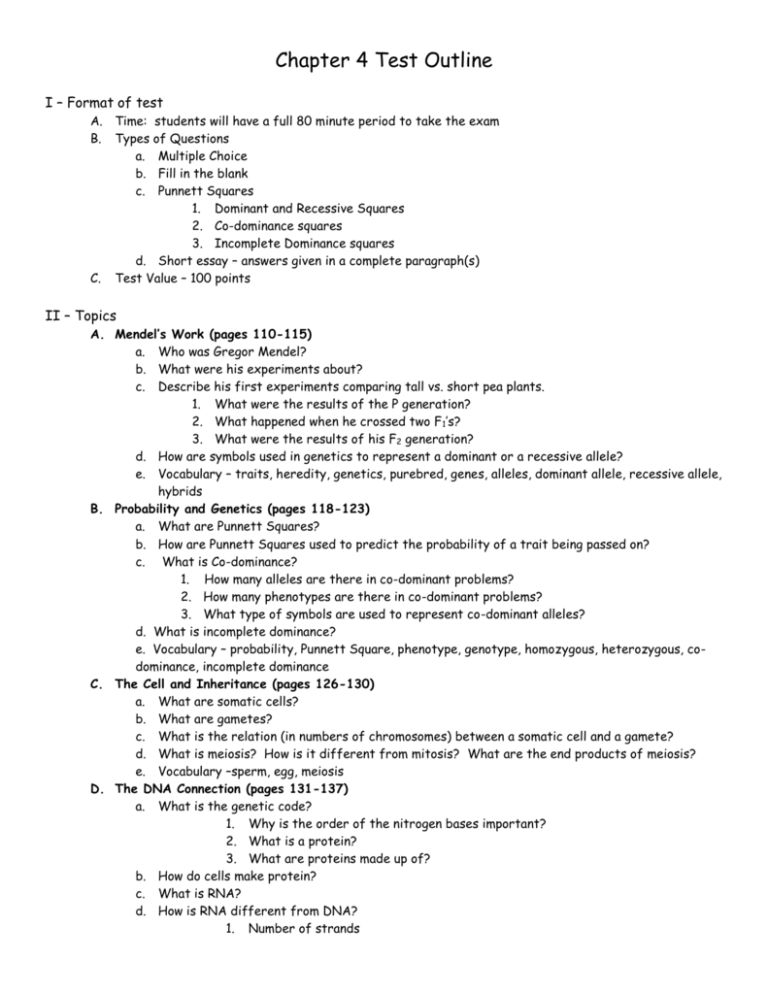Chapter 4 Test Outline - Conackamack Middle School
advertisement

Chapter 4 Test Outline I – Format of test A. Time: students will have a full 80 minute period to take the exam B. Types of Questions a. Multiple Choice b. Fill in the blank c. Punnett Squares 1. Dominant and Recessive Squares 2. Co-dominance squares 3. Incomplete Dominance squares d. Short essay – answers given in a complete paragraph(s) C. Test Value – 100 points II – Topics A. Mendel’s Work (pages 110-115) a. Who was Gregor Mendel? b. What were his experiments about? c. Describe his first experiments comparing tall vs. short pea plants. 1. What were the results of the P generation? 2. What happened when he crossed two F 1’s? 3. What were the results of his F2 generation? d. How are symbols used in genetics to represent a dominant or a recessive allele? e. Vocabulary – traits, heredity, genetics, purebred, genes, alleles, dominant allele, recessive allele, hybrids B. Probability and Genetics (pages 118-123) a. What are Punnett Squares? b. How are Punnett Squares used to predict the probability of a trait being passed on? c. What is Co-dominance? 1. How many alleles are there in co-dominant problems? 2. How many phenotypes are there in co-dominant problems? 3. What type of symbols are used to represent co-dominant alleles? d. What is incomplete dominance? e. Vocabulary – probability, Punnett Square, phenotype, genotype, homozygous, heterozygous, codominance, incomplete dominance C. The Cell and Inheritance (pages 126-130) a. What are somatic cells? b. What are gametes? c. What is the relation (in numbers of chromosomes) between a somatic cell and a gamete? d. What is meiosis? How is it different from mitosis? What are the end products of meiosis? e. Vocabulary –sperm, egg, meiosis D. The DNA Connection (pages 131-137) a. What is the genetic code? 1. Why is the order of the nitrogen bases important? 2. What is a protein? 3. What are proteins made up of? b. How do cells make protein? c. What is RNA? d. How is RNA different from DNA? 1. Number of strands 2. The sugar 3. Different nitrogen base – uracil instead of thymine? e. What are the two types of RNA? 1. messenger RNA (mRNA) – what is its role? 2. transfer RNA (tRNA) – what is its role? f. What happens during ht eprocess of protein synthesis? 1. Messenger RNA production 2. Messenger RNA attaches to a ribosome 3. Transfer RNA attaches to messenger RNA 4. Protein production complete g. What is a mutation? 1. What are the two types of mutations? a. Inherited – occurs in a sex cell; can effect the entire organism b. Acquired – occurs in a body cell; only effects those cells that carry the mutation h. Vocabulary – RNA. Messenger RNA, transfer RNA, codon, mutation III – Punnett Square Practice A. Dominance and Recessiveness Ex. In humans, the ability to roll your tongue is dominant to not being able to roll your tongue. Complete the following crosses. 1. Cross two parents, one who is homozygous dominant and one who is homozygous recessive for the trait. Report all genotypes and phenotypes. 2. Cross two parents who are both heterozygous for the trait. Report all genotypes and phenotypes. 3. If a child can NOT roll their tongue, what can be said of her parents? B. Incomplete dominance Ex. In a flower called snap dragons, the colors of the purebreds are red and white, while the hybrid form of the flower has a pink phenotype. Complete the following questions. 1. Write down the genotypes for each color of flower. (Ex. RR would be a red snapdragon, rr would be a white snapdragon.) 2. Cross two flowers, one red and one white. Report all genotypes and phenotypes. 3. Cross two flowers, both pink in color. Report all genotypes and phenotypes. C. Co-dominance Ex. In roosters, feather color is a co-dominant trait. There are roosters that are black, white, or the hybrids show a mixture of BOTH feather. 1. Write down the genotypes for each color of rooster. (Ex. F BFB would be a black rooster, FWFW would be a white rooster.) 2. Cross two roosters, one black feathered and one mixed feathered. Report all genotypes and phenotypes. IV– Resources for Study A. B. C. D. E. F. G. Textbook pages 110-137 Cornell Notes DO NOW’s and homeworks Other class work – including the Blahblah birds exs. and bikini bottom genetics worksheets Chapter 4 Test Review pages 139-140 Jeopardy game questions and answers Your teacher’s web page – Chapter 4 Resources






